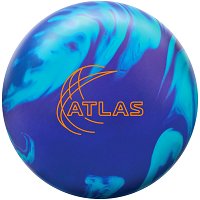Coupon excludes instant bonus items, hot deal items, and gift certificates.
The 11th Frame: Commissioner Tom Clark expects PBA deal with Bowlmor AMF
The 11th Frame: Commissioner Tom Clark expects PBA deal with Bowlmor AMF

JEFF RICHGELS
Those who consider Bowlmor AMF to be an enemy of serious bowling are going to be shocked at what I am about to write and what is soon to happen, according to PBA Commissioner Tom Clark.
“It does look like they are going to do some sponsorship or advertising with the PBA, which I hope let’s people know they do care about 'real' bowling,” Clark said of Bowlmor AMF in a recent interview. “It hasn’t happened yet, but we’re really deep in talks and at this point it would be shocking to me if we didn’t work something out together, hopefully sooner rather than later.”
The deal is likely to be a combination of having events and having Bowlmor AMF as a sponsor of PBA, Clark said, adding that the sides continue to have open dialogue about ways to partner, including meetings in New York City.
AMF hasn’t put any money toward the PBA for years, he said.
Clark said he has been talking with Bowlmor since they bought AMF, which at one point had a former Disney executive at its chief marketing officer.
“I even had the owners of the PBA meet with him and we were talking about a sweeping title sponsorship of the PBA and redefining the way TV would show bowling,” Clark said.
Bowlmor AMF turned down that proposal but wanted to talk about a sponsorship that was a little smaller, Clark said, before the former Disney executive left the company, setting things back.
Eventually, Clark revisited talking with the company after they spent a large sum on a great commercial that aired nationally.
The goal was to get the ad on PBA Tour TV shows “and then the next week they bought Brunswick,” Clark said.
In that deal in July, Brunswick announced that it had agreed to sell its Retail Bowling business (85 bowling centers) to Bowlmor AMF for $270 million, and intended to sell its Bowling Products business (balls, machines, lanes, etc.) by the end of 2014.
My initial story on the sale is here and my story featuring financial analyst (and PBA regional champion) Rob Plaza’s views of the deal is here.
Clark doesn’t expect Bowlmor AMF to do much to change how the Brunswick centers operate with leagues and tournaments.
“I think that (Bowlmor AMF CEO ) Tom Shannon likes the way the Brunswick centers were run,” Clark said. “He didn’t like the way AMF centers were run, but that’s pretty obvious — they went bankrupt. AMF was a mess they had to fix up. Most Brunswick centers are not doing that poorly and they have better management and staff and stuff like that, so there’s less to change about them. And a lot of them are fortified by leagues and regular bowlers so you have to keep them.“
In regard to the image Shannon has with some bowlers as being anti-serious bowling, Clark said he “seems fine to me,” and he believes the Brunswick deal “ultimately will end up being OK for everybody.”
Shannon, Clark added, “is putting his money where his mouth is, and is positive about the business of bowling above and beyond anyone right now. It’s like the PBA owners: they invested, they believed in it. You have these people that invest in (bowling) and they end up with more criticism than people sitting back wanting things for free.”
I have gone back and forth with Bowlmor AMF public relations since before interviewing Clark, but haven’t been able to set up an interview with a representative of Bowlmor AMF.
In pitching PBA to Shannon and his team, Clark said he tries to “make it clear to them to not think of this stodgy organization that will not bend to modern presentation. We don’t want a preconceived notion of what PBA is to turn someone off.“
Clark said that despite Brunswick's Bowling Products business being for sale and therefore in limbo and the centers being taken over by Bowlmor AMF, the PBA expects to continue with the partnerships it has for events at Brunswick centers, product registration of Brunswick bowling balls and other products, and with Brunswick as the official lane maintenance provider.
In essence, the sponsorship and advertising with Bowlmor AMF would be added to PBA’s existing partnerships with Brunswick.
Clark also covered several other issues in the wide-ranging interview, including that the upcoming World Series of Bowling will have just 1-hour shows for the four animal pattern tournaments, with the other three remaining 2 hours. Bowlers Journal broke that news in its August issue.
The hour shows still will feature four bowlers, with seeds 2, 3 and 4 competing in the first match and the winner in the title match.
“That’s something I want to do,” he said. “It’s not ESPN saying you have to do 1-hour shows.”
One reason is that he believes the “general audience might have an appetite for a quicker show and quicker conclusion to what’s going on. It’s always better to leave people wanting more than saying, ‘That was too long.’ “
The move also is aimed at what it’s about when it comes to anything on TV: ratings.
The four animal pattern events start Dec. 14 and will be going against the NFL immediately following the NFL pre-game show on ESPN.
“We end up with a lot of holdover people, so ratings usually are strong at the top of the show and then people begin to find their way to an NFL game,” Clark said. “A shorter show invites more people to stay with us to the conclusion, so we compete less against the NFL when we’re only an hour. I think it will be a chance to increase our ratings.”
The shorter shows also will cut down the amount of taping over that first weekend of November at South Point, so it should make it easier on production staff and fans, Clark said.
The risks are giving up an hour of time bowling is on TV and the inventory for commercials, promotional opportunities, etc.
For this viewer, last year’s 2-hour shows from the World Series that featured the trick shot segments with Terrell Owens did drag on, and those segments ruined some of the continuity as they came between the semifinal and title match. I did enjoy them, but I found myself going forward on my DVR to the title match after the semi and then returning to the trick shots to watch them. (I rarely get to see the shows when they air as I’m usually bowling.)
Clark also gave some general information on the 2015 PBA League, which is returning in part due to the support of sponsors GEICO and Barbasol.
The League will be taped in early 2015 at Bayside Bowl in Portland, Maine, which Clark described as a cool building that “feels like an arena,” and result in the four shows that will conclude the season on ESPN March 29 and April 5, 12 and 19.
It will be eight teams with the same managers but a total re-draft for rosters with a random draw for draft order. The eligibility for draft spots will be based on PBA points, with, for example, the top 10 points (outside the franchise players) eligible for the first round. The two players not picked then go into the grouping for the second round.
“It makes sure people won’t go off the board for any goofy picks or anything like that,” Clark said.
The managers are Mark Baker, Jason Couch, Carolyn Dorin-Ballard, Del Ballard, Tim Mack, Andrew Cain, Norm Duke and Johnny Petraglia.
The franchises, logos and celebrities will be the same, although Pittsburgh could switch to Oakland since celebrity owner Lamar Woodley now plays with the Raiders instead of the Steelers.
“We want to keep those brands and logos going,” Clark said.
The shows will be two quarterfinal matches on each of two shows, then two semis on one show and the title match on one show.
The format for the first three shows will be 2-game Baker matches, while the title match will be singles, doubles, trios and team like in the 2014 PBA League, Clark said.
More details on the 2015 PBA League will be released later, Clark said, adding that “there’s a lot to still be decided.”
A big highlight of the 2015 season will be the 50th anniversary of the Tournament of Champions, with the week in Indianapolis kicking off with a Hall of Fame induction. The Hall of Fame vote is still to come.
The prestigious major tournament will be held at Woodland Bowl in Indianapolis Feb. 11-15, with all PBA champions eligible.
More details on the TOC are in this recent PBA news release.
Clark also said the plan is for blue oil to be used “any time we are on TV except the Masters,” where the decision would be USBC’s.”
“I haven’t met anybody who doesn’t like it from outside of the traditionalist world,” Clark said of the visible oil. “Obviously, there is some dissension in bowling about it. But outside of bowling everybody likes it — ESPN and sponsors. Most of the complaints are kind of lame, like that it makes it easier, which it doesn't.”
Clark said he’d love to have a full tournament using the oil, but nothing has been scheduled.
Clark also confirmed that ESPN has expressed interest in televising PBA50 Tour competition.
“The name that gets everybody excited still in bowling is Pete Weber,” Clark said. “And I think an executive noticed that Pete Weber was bowling in championships in the PBA50. It was the first time I had ever had a long conversation about the PBA50 Tour with ESPN.
“We have been sneaking them on (ESPN) in different ways. In the past, they always didn’t want senior bowling. But the most recent conversation was how can we get them on more? It’s a good opening and we’ll see what we can do.”
It’s likely nothing would happen until the 2016 season, and a logical format might be a resurrection of the PBA-PBA50 doubles, he said.
“That would be a good show,” Clark said. “But you never know dealing with TV executives. Their opinions and budgets and needs for programming change all the time.”
Speaking of the PBA50 Tour, the chatter toward the end of this season was that the dominance by Hall of Famers this year was hurting entries.
Clark said he felt it might be more about the length of the season and people not having enough time off, and also said that one way to counter the situation if it is a factor is to find ways to monetize the interest guys like Weber draw so prize funds can go up for the PBA50 bowlers.
“The Super Senior event (in Fort Wayne, Indiana) had 130 entries but I don’t think if we had 12 Super Senior events there would be 130 at the last one,” he said.
Clark said he feels that PBA has stabilized and is in position take advantage of growth opportunities.
“I feel better about our direction now than I have because we were able to stem that tide of a poor budget prediction in previous years and we’re budgeting realistically,” he said. “We’re self-sufficient and it enables us to make better business decisions. And it also means if something good happens then all of a sudden we can grow.
“For some reason people got used to the idea that you don’t have to make money to pay. And that was true for a while because our owners were kind of like investors in the PBA for several years. They allowed us to overspend and covered that based on thinking they’d get a rights fee at some point. They really were hoping that ESPN would step up with like a $75 million rights fee at some point because of the success they would have. That’s not a bad way to think, but with that not happening it put us in a position where there was no more direct investment and we’d have to make it work on our own.”
There still are almost as many professional bowlers as in those subsidized years, but they live differently: traveling globally, doing more coaching, depending more on sponsors.
Clark said the things happening “give me hope,” and that should be the theme among bowlers, rather than the negativity that is common.
“For a while, I almost didn’t blame them,” he said of those who are negative. “But I think we’ve got some opportunities and I wouldn’t want to see those opportunities hurt by negativity.”
Clark said one of those opportunities is a new "PBA Network" about to be launched that will feature Xtra Frame, the PBA Youtube channel and the PBA Bowling Challenge game, among other things.
“These our opportunities for growth in new revenue streams that could break wide open any day as we add content and better monetize our fan base like all professional sports do,” he said.
The dream of many is a true PBA Tour that tours the country with full tournaments week after week like in the golden years.
The key to that — and many other big things — happening is rights fees from a TV network.
Back when the PBA had a true Tour, it was because “ABC paid the PBA to be on the air and paid for production of the shows,” Clark said. “We actually don’t have bad deals with ESPN and CBS (Sports Network) now. They help with production. A lot of smaller sports jealous of our relationship with ESPN — swimming would like to be on ESPN for 16 straight Sundays — but our deal doesn’t cover all of our production and doesn’t offer us a payment we can use against our bottom line.”
And that pales in comparison to, for example, the $1.1 billion deal FOX agreed to for the acquisition of rights to golf’s U.S. Open for a dozen years and the $90 million per year in deals Major League Soccer recently signed.
“It’s the way you can grow in today’s sports world,” Clark said. “Sponsorships are like gravy. The baseline is rights fees .”
A big rights fee deal would make it “so you almost can’t fail,” Clark said.
“Two years ago we shopped the ESPN deal and talked to almost every network and that’s how the CBS deal was born,” Clark added. “But it was not a more compelling offer than what ESPN offered us.”
And the ESPN deal is “really still the biggest single reason for the viability of the PBA,” Clark said.
“Securing rights fees is about growing bowling’s fan base,” he said. “If we can prove an overwhelming interest by a great passionate group, now the network wants to invest in it. It’s, ‘Here’s your $10 million make this work.’
“One of the virtues of staying alive is any day I could get a phone call from a network saying we want a 5-week series this summer. The more good stuff you have the more chances you can get the interest of a network that wants programming.”















